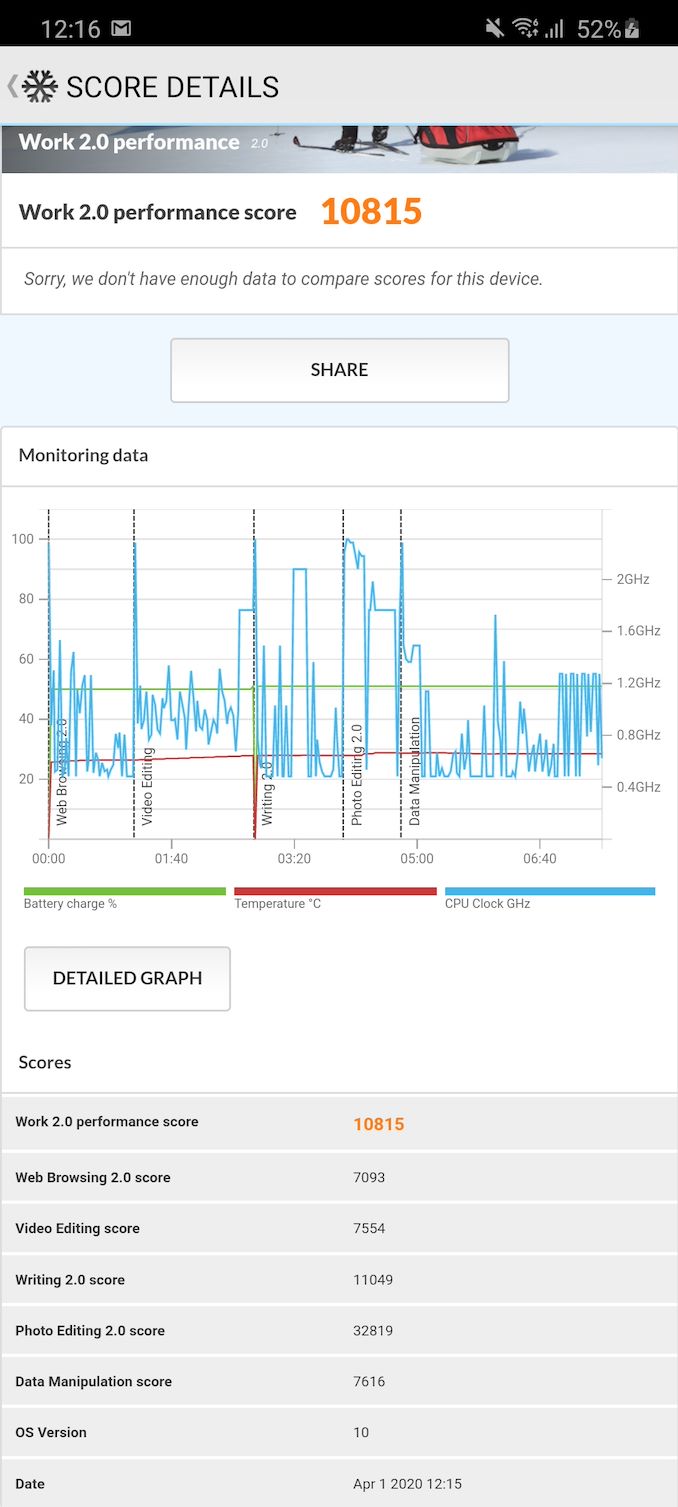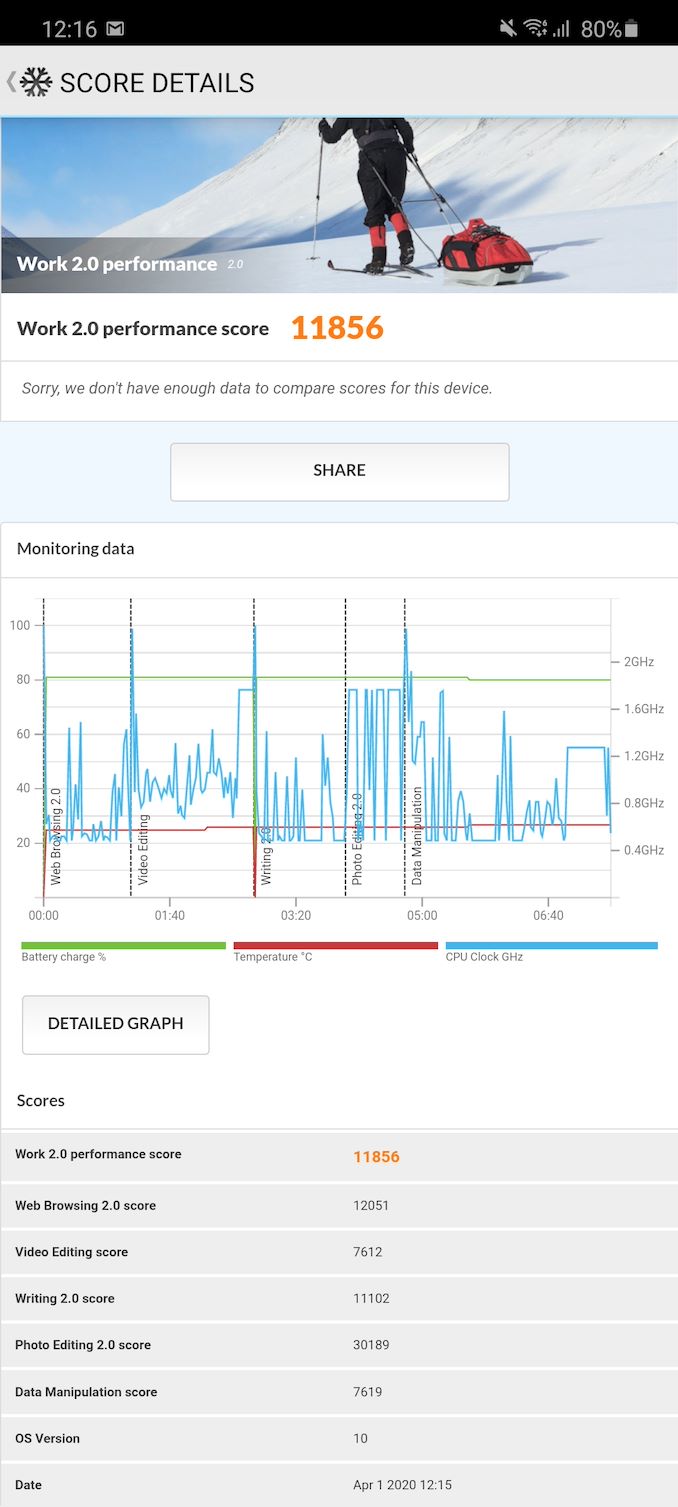The Samsung Galaxy S20+, S20 Ultra Exynos & Snapdragon Review: Megalomania Devices
by Andrei Frumusanu on April 3, 2020 9:30 AM ESTSystem Performance: 120Hz Winner
Although the peak CPU performance of the two Galaxy S20 SoCs isn’t all that different, what also matters is how the software decides to use that computing power. We’ve seen in the past that the DVFS and scheduler settings can have a very big impact on everyday performance of a device, sometimes even more so than the actual hardware. We’ve already quickly visited the Snapdragon 865 in the Galaxy S20 Ultra a few weeks ago, and we were very impressed by the performance and efficiency of the device. Now what remains to be seen how the Exynos 990 variant of the phone behaves.
Also at play here is the phone’s 120Hz display refresh mode. Samsung gives the option to choose between 60Hz and 120Hz in the display settings, with the latter naturally giving you more fluidity in applications. Beyond that, there’s also the matter of the device’s battery modes, in particular the difference between the default “Optimized” and “Performance” modes.
On past Samsung devices we’ve always tested the phones in their performance modes, as I hadn’t really noted much of a battery life difference between the two modes – and naturally we want to experience the full performance of a flagship device anyhow. This is still valid for the Snapdragon 865 Galaxy S20s, however the Exynos 990’s Performance mode is behaving weirdly and incurs quite a large power penalty, to the point that I would strongly recommend against using it. So the most practical comparisons for most people will be the Snapdragon Performance mode figures (P) against the default Exynos figures, at least for the S20 and at least for the current firmware versions.

Starting off in the web browsing test in PCMark, there’s a very clear performance difference between the two phones, however this isn’t just because the Exynos 990 somehow sucks, but because there’s a weird software configuration on the S20 Ultra.


Exynos 990 - Galaxy S20 Ultra 120Hz vs Galaxy S20+ 120Hz
Oddly enough the web browsing test is the most sensitive to a DVFS, scheduler, or Android task management setting difference between the Exynos S20 Ultra and the S20+. The latter here performs significantly better for some reason.

In the video editing test, the differences are minor, and in general the 120Hz results of the phones are clearly different to the 60Hz results. The test is generally V-sync limited here and isn’t all that representative of workloads anymore as most phones ace it nowadays. It’s again the Exynos in the 60Hz Performance mode which stands out of the crowd, getting better scores due to its extremely aggressive scheduling.

The Writing subtest is amongst the most important in the suite and most representative of everyday performance. Here the Snapdragon 865 is ahead of the Exynos by a good margin, and falls in line with the best scores we saw on the QRD865 in Performance mode. The Exynos, generationally, is also posting a good improvement over the Exynos 9820 of the Galaxy S10.

It seems SLSI has finally resolved their performance issues of their Renderscript drivers – either that, or the new Mali-G77 GPU is doing significantly better than the G76 in these workloads. Both variants of the S20 phones here clearly ends up with top performance scores, leading the pack ahead of all other Android devices.

In the Data Manipulation test, the scores are again quite good for both variants of the phone, however the Snapdragon 865 model does lead here, especially in the 120Hz mode. In fact, in this test it fares quite a lot better than the QRD865.

In the overall scores, both variants of the S20 Ultra are top performers. As a reminder, the Exynos 990 S20+ fared a bit better than our Ultra unit for some reason, but we’re opting to show the two Ultra scores here for best apples-to-apples between phones.
Web Benchmarks

In Speedometer 2.0, performance of the Exynos 990 chip isn’t all that much better than its predecessor, only sporting 12% increase. The Snapdragon variant on the other hand is 31% ahead of its S10 sibling, also posting notably better than what we had measured on the QRD865. It’s still far away from what Apple’s microarchitectures are able to achieve – the combination of strong CPUs along with better optimized browser JS engines is key to the iPhone performance.

In WebXPRT, the situation again favors the Snapdragon 865 variant of the phone by 17%.

Finally, in JetStream 2, the extend its lead to 24% which is quite large. Samsung’s custom CPU cores are particularly weak here and that’s likely due to the high instruction throughput of the test. I had found out their microarchitecture is quite weak with larger code sizes, for example unrolling loops will greatly handicap the performance of the Exynos CPUs whilst the Arm cores essentially see no big differences.
Performance Verdict: Both Winners, 120Hz Overshadows SoC Differences
Overall, I wasn’t disappointed with either variant of the S20. Both phones felt faster than Snapdragon 855 devices, the Snapdragon 865 variant of the S20 Ultra was just a little faster than the Exynos 990 variant.
The biggest improvement is user experience though it’s the 120Hz display mode. It’s just a fantastic addition to the phones, and really makes scrolling content that much more fluid. Along with the 240Hz touch input sampling rate of the phones makes these by far the most responsive and smooth experiences you can get on a mobile phone today.










137 Comments
View All Comments
toyeboy89 - Friday, April 3, 2020 - link
I'm really amazed in the fact that the iPhone XR is still beating snapdragon 865 in GFXBench in both peak and sustained performance. I am hoping the OnePlus 8 has better sustained performance.TMCThomas - Friday, April 3, 2020 - link
Amazing review! Always wait for this one before getting a new samsung. And I won't be getting any of the s20 phones. For me the kind of feel like "beta" phones. The 120hz which is not quite ready for 1440p yet, the underutilized 108mp camera, the space zoom which is blurry, the camera hole still being there the big camera bump and so on. I think all these features and more could be way more refined with the next galaxy s which I'll be waiting for. Also the poor exynos 990 performance especially the GPU part is just unacceptable to me. Especially with it probably being a lot better next year, so I'll skip this yearwheeliebin - Friday, April 3, 2020 - link
Thanks Andrei, really good review!I have read many users complain about extra crazy post-processing on the S10/S20 series when there is a face detected in the frame. i.e. the phone will apply an aggressive 'smooth skin' filter that you can't disable unless you shoot RAW. I was hoping that your review might touch on this however there were no people in your example shots so perhaps you didn't get a chance to experience the problem. I wonder if you have heard of this issue and can replicate it yourself with the S20 range?
anonomouse - Friday, April 3, 2020 - link
Hi Andrei, did you also run the bandwidth and MLP sweeps from previous reviews? Last year you noted the Snapdragon 855/A76 had peculiar behavior in the L1, and it would be also interesting to see if there are any MLP changes in both the SD865 and the Exynos.anonomouse - Friday, April 3, 2020 - link
Also, any idea why the new scores for these in 403.gcc seems to be worse than their previous generation products? In particular the score for the SD865 in these S20s is substantially worse than the SD865 score from the QRD preview article.Andrei Frumusanu - Saturday, April 4, 2020 - link
Yes I know. I don't know why that happens. I also got a V60 now and the scores there are higher, I'm wondering if there's something with Samsungs shared libraries.anonomouse - Sunday, April 5, 2020 - link
What type of compile flags are used for these binaries? Are they the same for all of the tested binaries (or even same binary on each given platform)? Are LTO or PGO used (and if not why not)?I'm also not convinced of this statement from the article:
"I had mentioned that the 7LPP process is quite a wildcard in the comparisons here. Luckily, I’ve been able to get my hands on a Snapdragon 765G, another SoC that’s manufactured on Samsung’s EUV process. It’s also quite a nice comparison as we’re able to compare that chip’s performance A76 cores at 2.4GHz to the middle A76 cores of the Exynos 990 which run at 2.5GHz. Performance and power between the two chips here pretty much match each other, and a clearly worse than other TSMC A76-based SoCs, especially the Kirin 990’s. The only conclusion here is that Samsung’s 7LPP node is quite behind TSMC’s N7/N7P/N7+ nodes when it comes to power efficiency – anywhere from 20 to 30%."
Both the energy consumed and the performance scores for both of these A76's seem to also very closely track the "mid" 2.43Ghz A76's on the TSMC-fabbed SD855 - all of which have similar L2's and similar frequencies, but possibly differ significantly (to the point of being suboptimal on latency) on the memory hierarchy and SoC beyond that - which greatly affects many of the SPEC workloads. All of these may also have implementation targets. Given this, is it really conclusive that the Samsung process is truly 20-30% worse in energy efficiency? Granted, things will probably not look pretty next year when TSMC is on a true 5nm and Samsung is not.
Andrei Frumusanu - Monday, April 6, 2020 - link
The test is just -Ofast without any other addition. LTO wasn't/isn't in a good state on the Android NDK - it's something to look into in maybe a new binary revision.As for the 855 figures, well, that's also on an earlier 7nm. HiSilicon did a lot better in terms of they physical implementation. If not against N7, 7LPP clearly has a disadvantage against N7P/N7+.
Andrei Frumusanu - Saturday, April 4, 2020 - link
I'll add them in, that test takes a whole day and I needed the phones doing battery tests and other stuff.dad_at - Saturday, April 4, 2020 - link
Again, your S10+ Exynos results in pc mark are false as of 2020. In performance mode I easily get 9500 work 2.0 overall, about 9600 in browser bench, 21K in photo editing. PC mark in general is inconsistent, irrelevant benchmark, not representative of actual performance in daily usage. The same about these ancient SPEC synthetics. No one uses these for performance evaluation now.